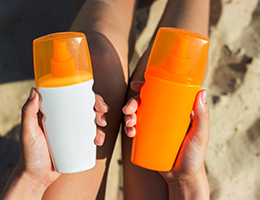
June 13, 2024—The sunscreen aisle is full of options, and that's a good thing. Sunscreen protects your skin from ultraviolet (UV) radiation, which can cause skin cancer and other skin problems, including wrinkles and age spots. But with all those choices, how do you choose?
Understand your options
There are two basic types of sunscreen—chemical and mineral—available, although some products contain both. While any sunscreen labeled broad-spectrum offers protection from both UVA and UVB rays, mineral and chemical sunscreens do work differently.
Chemical sunscreens, also called organic sunscreens, use active ingredients such as oxybenzone, avobenzone, homosalate, octinoxate, octisalate and octocrylene. These form a protective layer on the skin, absorbing harmful UV rays and converting them into heat. That layer takes time to become fully effective—which is why it's best to apply sunscreen at least 15 minutes before heading outside.
Mineral sunscreens are also called physical sunscreens. That's because their active ingredients are minerals—titanium dioxide, zinc oxide or both—which stay on the surface of the skin and deflect the sun's rays. Like chemical sunscreens, they also form a protective layer on the skin.
Pros and cons
At this point, you might be wondering which type of sunscreen is best for you. The short answer is: the type you'll use day in and day out. Other considerations include:
Skin benefits. For people with sensitive skin, mineral sunscreens may be a better option, says the American Academy of Dermatology (AAD). Avoiding products with added fragrances may help too. But options abound: Some products are oil-free, while others moisturize dry skin. Still others are specially formulated for sensitive skin. Think about your skin's needs.
White residue. Some sunscreens—particularly mineral sunscreens—can leave your skin looking white. A tinted sunscreen can eliminate this effect. That tinting may come with an added benefit: Iron oxide, another mineral, is used in tinted sunscreens. The AAD says that this ingredient helps protect against visible light from the sun, which can lead to dark spots.
Safety. The U.S. Food and Drug Administration (FDA) regulates sunscreen ingredients to ensure their safety and effectiveness. They are currently reviewing certain chemical sunscreen ingredients to understand any possible effects they might have when absorbed into the body. But it's important to remember that all sunscreen ingredients—chemical and mineral—used in the U.S. are considered safe when used as directed.
Environmental impact. Some states, such as Hawaii and Florida, have banned the use of sunscreens containing oxybenzone and octinoxate because of the possible risk of harm to coral reefs.
Cream, gel, stick or spray? Take your pick.
Whether you choose a chemical or a physical sunscreen product, choose one with an SPF of 30 or higher, and be sure to reapply often—every two hours, or sooner if you're swimming or sweating. Follow these guidelines to help protect your skin from harmful ultraviolet rays.
Sources
- American Academy of Dermatology Association. "Confused About Sunscreen? New American Academy of Dermatology Survey Shows Americans Need a Refresher on Sunscreen Application and SPF." https://www.aad.org/news/aad-survey-shows-americans-need-sunscreen-education.
- American Academy of Dermatology Association. "How to Decode Sunscreen Labels." https://www.aad.org/public/everyday-care/sun-protection/shade-clothing-sunscreen/understand-sunscreen-labels.
- American Academy of Dermatology Association. "Sunscreen FAQs." https://www.aad.org/media/stats-sunscreen.
- Skin Cancer Foundation. "What's the Sunscreen Situation?" https://www.skincancer.org/blog/whats-the-sunscreen-situation.
- Skin Cancer Foundation. "How to Choose the Best Sunscreen for Your Skin." https://www.skincancer.org/blog/how-to-choose-the-best-sunscreen-for-your-skin.
- UpToDate. "Selection of Sunscreen and Sun-Protective Measures." https://www.uptodate.com/contents/selection-of-sunscreen-and-sun-protective-measures.